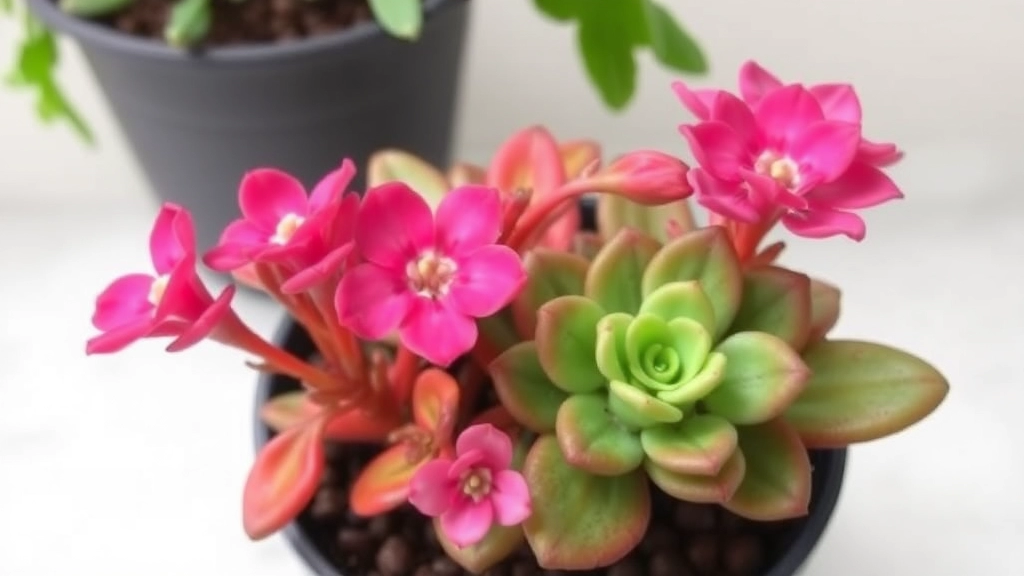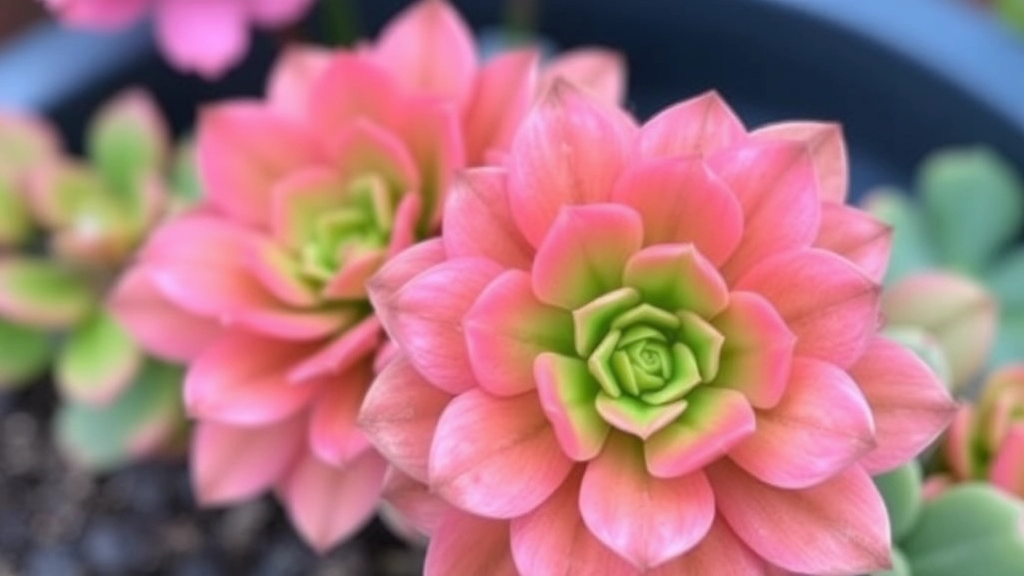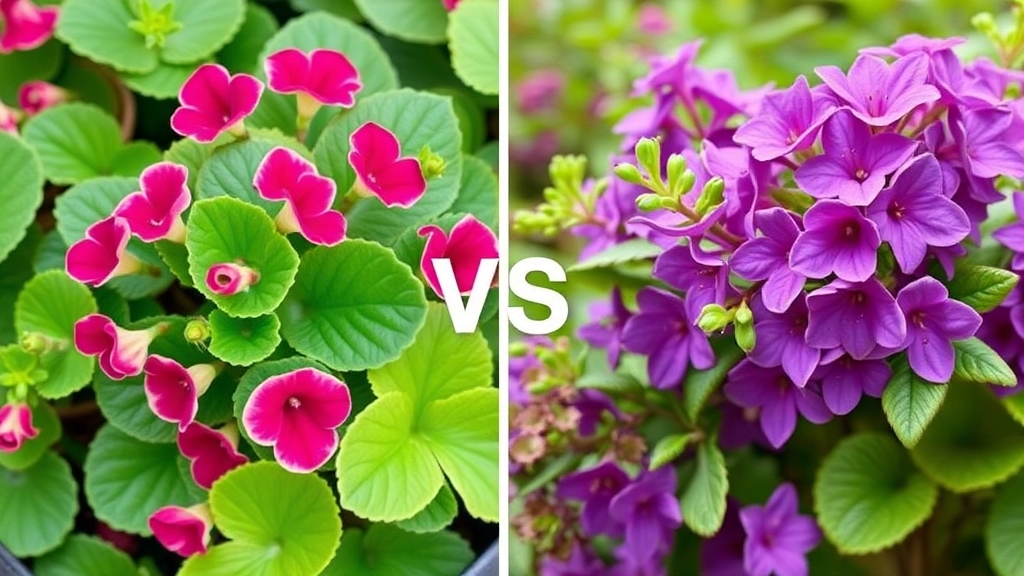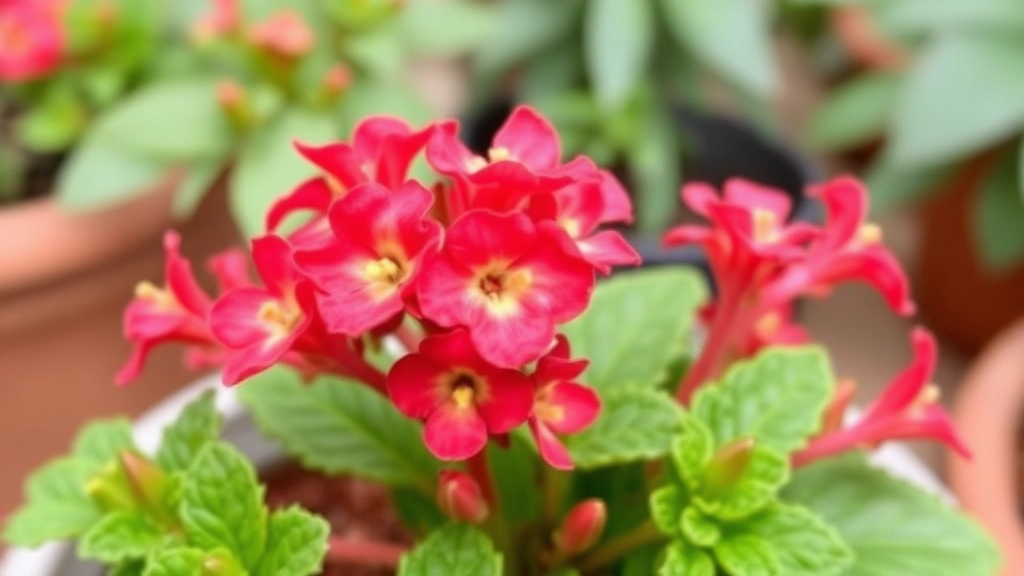Finding Plants That Resemble Kalanchoe
Are you curious about finding a plant that looks like kalanchoe but isn’t? You’re in the right place! Many plants resemble kalanchoe in appearance, making it tricky to tell them apart. Whether you’re a gardening enthusiast or just looking to decorate your space, knowing these lookalikes can be super helpful.
Common Kalanchoe Lookalikes
One common doppelganger is the Cotyledon variety, which shares similar fleshy leaves and vibrant colours. Another lookalike is found in the Crassula family, known for its thick, succulent leaves. Echeveria, with its rosette shape, is another popular plant often mistaken for kalanchoe.
Identifying These Fascinating Lookalikes
Let’s dive into these fascinating lookalikes and learn how to identify them!
When you’re browsing your local garden centre or exploring online plant shops, you may find yourself drawn to various succulents that bear a striking resemblance to Kalanchoe.
This can lead to confusion, especially for those who are new to the world of succulents.
Many plants share similar characteristics, making it essential to know the common lookalikes of Kalanchoe.
## Common Lookalikes
– **Cotyledon**
– Often mistaken for Kalanchoe due to their fleshy leaves.
– They have a more rounded leaf shape and often display a waxy texture.
– **Echeveria**
– This popular succulent has rosettes that can easily be confused with Kalanchoe.
– Echeveria leaves tend to be more pointed and can come in various colours.
– **Crassula**
– With its thick leaves and compact growth, Crassula is another close relative.
– However, Crassula plants usually have a more upright growth habit.
– **Senecio**
– Some Senecio species, like Senecio mandraliscae, have a similar appearance.
– They often feature elongated leaves, which set them apart.
– **Sedum**
– Known for their low-growing habits, Sedum varieties can resemble Kalanchoe in foliage.
– Sedum leaves are typically flatter and can spread out more.
Understanding these common plants that resemble Kalanchoe can help you make informed choices when selecting succulents for your collection. For more detailed information on Kalanchoe varieties and their care, check out the [ultimate guide to growing and caring for succulent plant Kalanchoe](https://planthq.org/ultimate-guide-to-growing-and-caring-for-succulent-plant-kalanchoe/). Additionally, if you’re interested in learning about specific types like the [Kalanchoe Tomentosa Chocolate Soldier](https://planthq.org/kalanchoe-tomentosa-chocolate-soldier-care-and-tips/), there are resources available to help you get started.
Differentiating Between Kalanchoe and Cotyledon Varieties

Have you ever found yourself staring at a plant, unsure whether it’s a Kalanchoe or a Cotyledon? You’re not alone! These two succulent families can be quite similar, but knowing how to tell them apart can save you a lot of confusion.
Key Differences
- Leaf Shape and Texture
- Kalanchoe: Typically has thicker, fleshy leaves that are often smooth and glossy. Some varieties have scalloped edges.
- Cotyledon: Usually features more varied leaf shapes, often with a powdery coating. The leaves can be rounded or elongated and tend to feel a bit softer.
- Growth Habit
- Kalanchoe: Grows upright, forming a bushy appearance. It can get quite tall, especially when flowering.
- Cotyledon: Often has a more sprawling or rosette form, making it look a bit more laid-back in your garden or home.
- Flowering
- Kalanchoe: Known for vibrant, tubular flowers that bloom in clusters. They can be red, pink, yellow, or white, depending on the variety.
- Cotyledon: While it does flower, its blooms are usually less showy and more bell-shaped, often in shades of orange or yellow.
- Care Requirements
- Kalanchoe: Prefers bright, indirect sunlight and needs watering only when the soil is dry.
- Cotyledon: Thrives in full sun and requires slightly more frequent watering, especially during its growing season.
Quick Tips for Identification
- Look at the Leaves: If they’re thick and shiny, you’re likely dealing with a Kalanchoe.
- Check the Growth: Upright? That’s Kalanchoe. Sprawling? It’s probably a Cotyledon.
- Observe the Flowers: Bright clusters point to Kalanchoe; more subtle blooms suggest Cotyledon.
Kalanchoe Lookalikes in the Crassula Family
When exploring the diverse world of succulents, it’s easy to stumble upon various plants that bear a striking resemblance to Kalanchoe. One notable family that features several lookalikes is the Crassula family.
Understanding Crassula Varieties
Crassula plants are known for their fleshy leaves and compact growth, much like Kalanchoe. Here are a few Crassula varieties that may catch your eye:
- Crassula ovata (Jade Plant)
This popular succulent features thick, glossy leaves that can sometimes mimic Kalanchoe’s appearance.
It’s often grown for its attractive foliage and is believed to bring good luck. - Crassula perforata (String of Buttons)
With its unique stacked leaves, this plant offers a different texture while still sharing a similar growth habit.
It’s a great choice for hanging baskets due to its trailing nature. - Crassula tetragona (Miniature Pine Tree)
This one stands out with its upright growth and needle-like leaves, providing a distinctive look while still fitting within the family resemblance.
Key Characteristics to Differentiate
While Kalanchoe and Crassula plants may share similarities, there are subtle differences to help you distinguish between them:
- Leaf Shape: Kalanchoe often has broader, more rounded leaves, whereas Crassula tends to exhibit a variety of shapes, from oval to elongated.
- Growth Habit: Kalanchoe usually has a bushier appearance, while many Crassula varieties can grow taller or more compact.
- Flowering Patterns: Kalanchoe is known for its vibrant flowers, while Crassula may produce smaller, less showy blooms.
If you’re interested in learning more about Kalanchoe care, check out our ultimate guide to caring for Kalanchoe succulents. Additionally, for those looking to add a Kalanchoe to their collection, explore the best places to buy Kalanchoe tomentosa online.
Echeveria: A Popular Kalanchoe Lookalike
Are you often confused by the striking similarities between Echeveria and Kalanchoe? You’re not alone. Many plant enthusiasts face this dilemma, as both belong to the succulent family and boast a range of attractive features.
Echeveria is a genus of rosette-forming succulents that share many characteristics with Kalanchoe. Here’s how to differentiate them and appreciate their unique beauty:
- Leaf Shape and Texture:
- Echeveria leaves are typically thicker and more fleshy, often forming a compact rosette shape.
- Kalanchoe leaves can be broader and may have a more varied texture, sometimes featuring a waxy coating.
- Flowering Patterns:
- Echeveria flowers tend to bloom in clusters on tall stems, showcasing vibrant colours like coral, pink, or yellow.
- Kalanchoe flowers are often smaller and may appear in dense clusters, with a more diverse colour palette.
- Growth Habits:
- Echeveria generally grows more upright and can form a larger rosette over time.
- Kalanchoe varieties can be more bushy or trailing, depending on the species.
Echeveria is not just a pretty face; it’s also easy to care for, making it a favourite among both novice and experienced gardeners. Here are some care tips:
- Light Requirements:
- Echeveria thrives in bright, indirect sunlight.
- Ensure it receives at least 6 hours of light daily.
- Watering Needs:
- Water sparingly, allowing the soil to dry out completely between waterings.
- Overwatering can lead to root rot, so it’s essential to be cautious.
- Soil Type:
- Use well-draining soil, ideally a cactus or succulent mix.
When exploring the world of succulent plants, it’s not uncommon to encounter species that bear a striking resemblance to Kalanchoe. Among these, the Senecio genus stands out, often causing confusion for plant enthusiasts and gardeners alike.
Senecio species, known for their diverse forms, can mimic Kalanchoe in both appearance and care requirements. Here are some key characteristics to help you differentiate between the two:
– **Leaf Structure:**
– Kalanchoe leaves are typically fleshy and can be smooth or slightly serrated.
– Senecio leaves might be more elongated or have a unique shape, like the popular Senecio radicans, which has trailing, bead-like leaves.
– **Growth Habit:**
– Kalanchoe tends to grow upright, forming a bushy appearance.
– Many Senecio varieties, such as Senecio mandraliscae, are more trailing or creeping, making them ideal for hanging baskets.
– **Flowering:**
– Kalanchoe produces clusters of small, tubular flowers in various colours, often blooming in winter or early spring.
– Senecio flowers are usually bright yellow and resemble daisies, blooming in late summer.
Both Kalanchoe and Senecio thrive in similar environments, but there are subtle differences in their care:
– **Light Requirements:**
– Kalanchoe prefers bright, indirect sunlight.
– Senecio can tolerate more direct sunlight, making it suitable for sunny windowsills.
– **Watering Needs:**
– Kalanchoe requires moderate watering, allowing the soil to dry out between sessions.
– Senecio is more drought-tolerant and can go longer without water.
Understanding these differences will not only help you identify these beautiful plants but also ensure you provide them with the right care. For more detailed information on how to care for different Kalanchoe species, you might find our guides on [how to care for Kalanchoe Tomentosa](https://planthq.org/how-to-care-for-kalanchoe-tomentosa-complete-guide/) and [optimal care for Kalanchoe Blossfeldiana](https://planthq.org/optimal-care-for-kalanchoe-blossfeldiana-growth/) particularly useful.
VI. Sedum: Another Kalanchoe Doppelganger

Have you ever found yourself confused between Kalanchoe and Sedum? You’re not alone!
Both of these succulent varieties share a similar aesthetic, making it tricky for even seasoned plant lovers to tell them apart.
What is Sedum?
Sedum is a diverse genus of succulent plants, often known for their fleshy leaves and vibrant colours.
Here’s why they can easily be mistaken for Kalanchoe:
- Leaf Shape: Both plants have thick, fleshy leaves.
- Growth Habit: They can grow in similar compact forms, making them look alike.
- Colour Variations: Sedum comes in a range of greens, reds, and purples, just like Kalanchoe.
How to Spot the Differences?
While they may look similar, here are some key differences to help you out:
- Flowers:
- Kalanchoe typically has clusters of small, tubular flowers.
- Sedum flowers are often star-shaped and can appear in clusters as well, but they have a different structure.
- Leaf Texture:
- Kalanchoe leaves are usually smoother and might have a waxy coating.
- Sedum leaves can be more varied, with some being hairy or having a slightly rough texture.
- Growth Patterns:
- Kalanchoe tends to grow upright, while Sedum can trail or spread, making it great for hanging baskets.
Caring for Sedum
If you’re thinking about adding Sedum to your collection, here are some easy care tips:
- Light: They thrive in bright, indirect sunlight.
- Water: Allow the soil to dry out completely between waterings.
- Soil: Use well-draining soil to prevent root rot.
When it comes to distinguishing Kalanchoe from its lookalikes, one of the most telling characteristics is their flowering habits.
Kalanchoe is renowned for its vibrant, tubular flowers that bloom in clusters, often showcasing a variety of colours, including red, pink, and yellow. For more comprehensive care tips, you can refer to the [ultimate guide on Kalanchoe care](https://planthq.org/how-to-care-for-kalanchoe-succulent-ultimate-guide/).
### Key Flowering Traits of Kalanchoe:
– **Clustered Blooms:** Flowers grow in dense clusters at the tips of the stems.
– **Seasonal Blooming:** Typically blooms in winter or early spring.
– **Long-Lasting Flowers:** Once in bloom, Kalanchoe flowers can last for several weeks.
In contrast, many of the plants that resemble Kalanchoe exhibit different flowering behaviours.
For instance, **Echeveria** often produces single blooms on elongated stems, with flowers that hang downwards. Their colours may be less vibrant than Kalanchoe, leaning more towards pastel shades.
### Key Flowering Traits of Echeveria:
– **Single Blooms:** Flowers appear individually rather than in clusters.
– **Blooming Season:** Generally flowers in late spring or summer.
– **Delicate Appearance:** Flowers tend to have a more subtle colour palette.
Meanwhile, **Cotyledon** species may display bell-shaped flowers that are also less densely packed than Kalanchoe’s.
### Key Flowering Traits of Cotyledon:
– **Bell-Shaped Flowers:** Typically grow on tall, slender stalks.
– **Blooming Season:** Often flowers in summer.
– **Varied Colours:** Can range from yellow to orange, but often lack the vibrancy of Kalanchoe.
Understanding these differences can help you identify not just Kalanchoe, but also its lookalikes effectively. For those interested in the unique varieties of Kalanchoe, check out this [complete guide on Kalanchoe Blossfeldiana](https://planthq.org/vibrant-kalanchoe-blossfeldiana-colors-a-complete-guide/).
Trailing Kalanchoe vs. Cissus: A Vining Comparison

Have you ever found yourself torn between the charming Trailing Kalanchoe and the vibrant Cissus?
Both are fantastic choices for adding some greenery to your space, but they have their own unique vibes.
Trailing Kalanchoe
- Known for its fleshy leaves and vibrant blooms.
- Typically has a more compact growth habit.
- Prefers bright, indirect sunlight.
- Water sparingly; it’s a succulent after all!
- Blooms in clusters, showcasing bright flowers that can last for months.
Cissus
- Often called the “Grape Ivy,” it has a more vigorous growth pattern.
- Features heart-shaped leaves that can create a lush, cascading effect.
- Thrives in a variety of light conditions, from low light to bright indirect light.
- Likes to be watered more regularly than Kalanchoe, but don’t overdo it!
- Rarely flowers indoors, focusing more on its stunning foliage.
So, which one should you choose? If you’re after vibrant flowers and a more compact plant, Trailing Kalanchoe is your go-to.
But if you want something that can really spread out and fill a space with lush greenery, Cissus might be the better option.
Common Uses and Care for Kalanchoe Lookalikes
When considering Kalanchoe lookalikes, it’s essential to understand their common uses and care requirements.
Common Uses
Kalanchoe and its lookalikes are popular choices for both indoor and outdoor gardening. Here’s how they can be utilised:
- Indoor Decor: Their vibrant foliage and flowers make them excellent choices for brightening up any room.
- Outdoor Landscaping: Many varieties thrive in gardens, adding texture and colour to rock gardens or borders.
- Gifts: Their hardy nature and stunning appearance make them thoughtful gifts for plant lovers.
- Medicinal Uses: Some Kalanchoe species are known for their medicinal properties, often used in traditional remedies.
Care Requirements
To keep Kalanchoe lookalikes thriving, follow these straightforward care tips:
- Light: Ensure they receive plenty of bright, indirect sunlight.
- Watering: Water sparingly; allow the soil to dry out between watering sessions.
- Soil: Use well-draining soil to prevent root rot.
- Fertilisation: Feed with a diluted fertiliser during the growing season.
- Temperature: Maintain a warm environment, ideally between 15°C and 25°C.
Additional Tips
- Pest Control: Keep an eye out for common pests like mealybugs and aphids. Treat promptly if spotted.
- Pruning: Remove dead leaves and spent flowers to encourage new growth.
By understanding the uses and care of Kalanchoe lookalikes, you can ensure they flourish in your home or garden. For specific care tips, you might find our complete guide on Kalanchoe Tomentosa useful. Additionally, if you’re interested in the medicinal benefits of Kalanchoe, check out our article on the health benefits of Kalanchoe Pinnata extract.
Best Lookalike Plants for Indoor and Outdoor Spaces
So, you’re looking to jazz up your indoor or outdoor space with some stunning plants that resemble Kalanchoe?
You’re in the right place!
Here’s a rundown of some of the best Kalanchoe lookalikes that will thrive in your home or garden.
FAQs: Differentiating Between Kalanchoe and Similar Plants
What are the main differences between Kalanchoe and Cotyledon?
Leaf Shape and Texture: Kalanchoe typically has thicker, glossy leaves, while Cotyledon features varied leaf shapes with a powdery coating. Growth Habit: Kalanchoe grows upright and bushy, whereas Cotyledon has a more sprawling or rosette form. Flowering: Kalanchoe has vibrant, tubular flowers in clusters, while Cotyledon’s blooms are bell-shaped and less showy. Care Requirements: Kalanchoe prefers bright, indirect sunlight and infrequent watering, while Cotyledon thrives in full sun and needs more frequent watering during its growing season.
How can I quickly identify if a plant is Kalanchoe?
Look at the Leaves: Thick and shiny leaves usually indicate Kalanchoe. Check the Growth: Upright growth suggests Kalanchoe. Observe the Flowers: Bright clusters of flowers are a hallmark of Kalanchoe.
Is Echeveria often mistaken for Kalanchoe?
Yes, Echeveria is a common Kalanchoe lookalike. Both belong to the succulent family and share many attractive features. Echeveria typically forms a compact rosette shape with thick, fleshy leaves and blooms in clusters on tall stems.
How do Echeveria and Kalanchoe differ in growth habits and care?
Growth Habits: Echeveria generally grows upright and forms larger rosettes, while Kalanchoe can be bushy or trailing. Care Tips: Echeveria thrives in bright, indirect sunlight and requires well-draining soil. Water sparingly, allowing the soil to dry out completely between waterings to prevent root rot.
What makes Sedum similar to Kalanchoe, and how can I tell them apart?
Both Sedum and Kalanchoe have thick, fleshy leaves and can grow in compact forms. However, Flowers: Kalanchoe has tubular flowers, while Sedum flowers are star-shaped. Leaf Texture: Kalanchoe leaves are smoother and may have a waxy coating, whereas Sedum leaves can be hairy or rough. Growth Patterns: Kalanchoe grows upright, while Sedum can trail or spread.
What are the care requirements for Sedum?
Sedum thrives in bright, indirect sunlight. Allow the soil to dry out completely between waterings and use well-draining soil to prevent root rot.
How does Trailing Kalanchoe compare to Cissus?
Trailing Kalanchoe: Known for its fleshy leaves and vibrant blooms, it has a compact growth habit and prefers bright, indirect sunlight. Water sparingly. Cissus: Also known as “Grape Ivy,” it has a vigorous growth pattern with heart-shaped leaves. It thrives in various light conditions and needs more regular watering than Kalanchoe. Cissus rarely flowers indoors but focuses on lush foliage.
Which plant should I choose: Trailing Kalanchoe or Cissus?
If you want vibrant flowers and a compact plant, go for Trailing Kalanchoe. If you prefer a plant that spreads out and fills a space with lush greenery, Cissus is the better option.
References
-
Differentiating Between Kalanchoe and Cotyledon Varieties
-
Echeveria: A Popular Kalanchoe Lookalike
-
VI. Sedum: Another Kalanchoe Doppelganger
